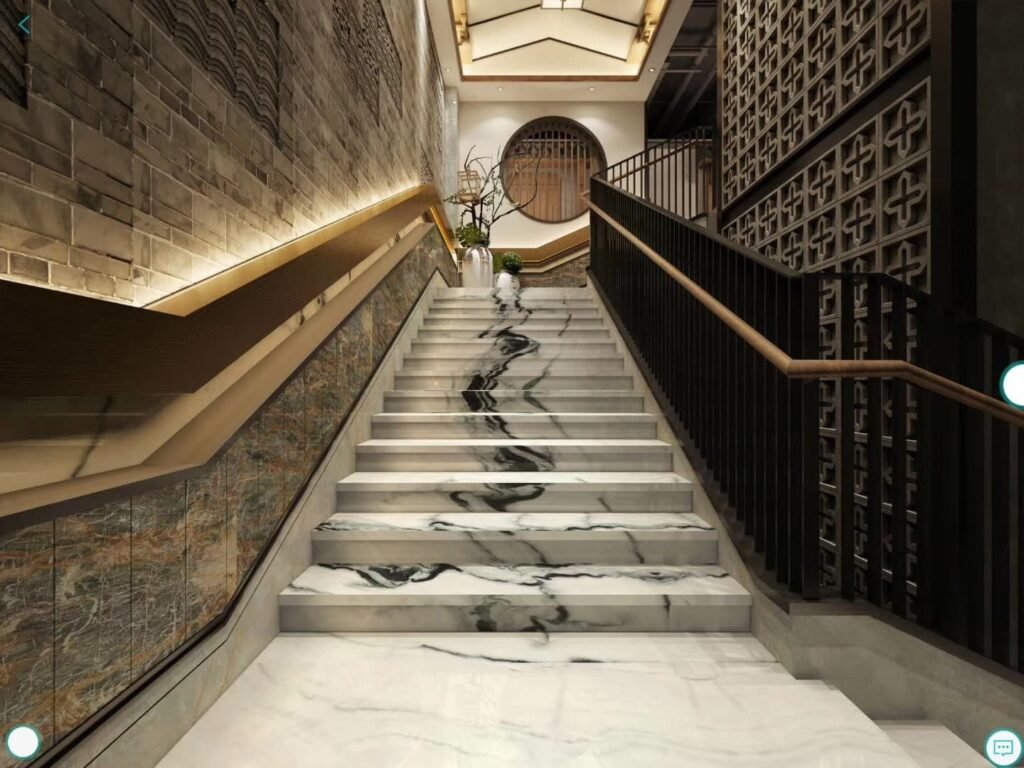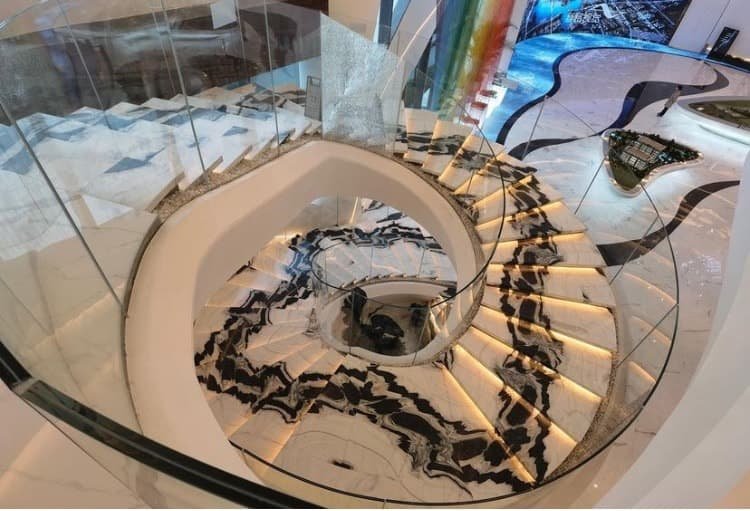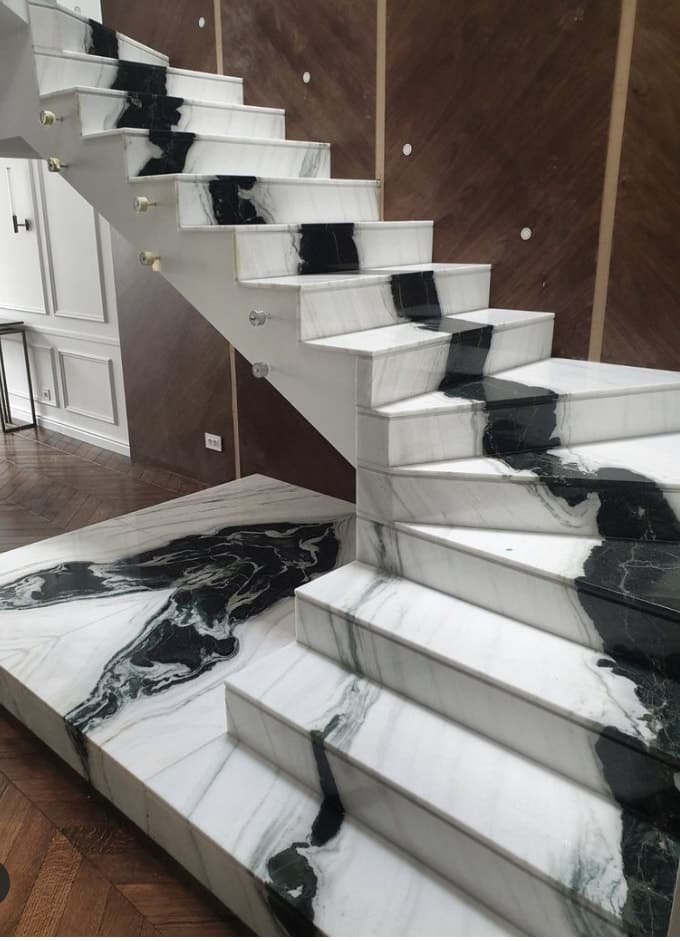Panda White Marble Stairs for Homes — Why They Win
Table of Contents
Toggle- Panda White Marble Stairs for Homes — Why They Win
- What Exactly Is Panda White Marble?
- 7 Stunning Benefits of Panda White Marble Stairs for Homes
- Potential Drawbacks (and How to Solve Them)
- Cost Breakdown & Budget Tips
- Design & Detailing Tips
- Safety & Code Considerations
- Installation Essentials
- Care & Maintenance
- Smart Alternatives (If You’re Comparing)
- FAQs
- Internal Resources (Related Reads)
- Final Word
Panda white marble stairs for homes combine high-end aesthetics with everyday durability, turning a circulation space into a showpiece. If you’re planning a staircase upgrade or specifying materials for a luxury project, Panda White’s striking black-and-white veining delivers instant drama while remaining timeless. Below, we explain what it is, seven standout benefits, cost ranges, design tips, safety considerations, and daily care—plus smart alternatives if you’re still comparing options.
Quick Take
Look: Bold, high-contrast black-and-white veining
Best for: Entry foyers, duplex lofts, penthouse features, boutique hotels
Edges/finishes: Eased, full bullnose, or mitered; honed or polished
Maintenance: Routine sealing and pH-neutral cleaning
Price drivers: Slab grade, thickness, finish, fabrication complexity, site logistics

What Exactly Is Panda White Marble?
Panda White is a natural marble recognized for its crisp white background and ribbon-like black veining—an on-trend, high-contrast aesthetic that reads contemporary yet classic. Compared to softer marbles, quality stock of Panda White is typically dense enough for treads and risers when fabricated correctly, supported by a solid substrate, and installed by experienced stone contractors.
Pro tip: If your staircase is a main focal point in an open-plan layout, Panda White’s “graphic” look provides a visual anchor and helps zone the space without walls.

7 Stunning Benefits of Panda White Marble Stairs for Homes
Instant Luxury Curb Appeal
Few materials make an entrance quite like Panda White. The bold veining photographs beautifully, elevating real-estate listings and showroom spaces.Design Versatility
Works with minimal modern interiors, monochrome palettes, or glamorous brass-and-glass schemes. The same slab can inform matching landings, skirtings, and custom nosing.Timeless Material Value
Natural stone has outlasted trends for centuries. Properly sealed and maintained, marble stair assemblies age gracefully and can be refinished.Thermal Stability
Stone resists daily temperature swings, making it comfortable underfoot (and compatible with radiant floor heat on adjacent landings).Custom Fabrication Options
From waterfall returns to curved winders, skilled fabricators can shape Panda White into complex geometries with bookmatched veins for a truly bespoke look.Compatibility with Metal/Glass
The stark veining pairs perfectly with blackened steel stringers or clear glass balustrades—an easy way to achieve gallery-level minimalism.Elevated Resale Narrative
“Natural marble staircase” is a compelling bullet in property marketing; it signals premium construction and meticulous detailing.

Potential Drawbacks (and How to Solve Them)
Scratch & Etch Sensitivity: As a calcium-based stone, marble can etch from acids (citrus, vinegar).
Fix: Choose a honed finish to disguise micro-etching, use pH-neutral cleaners, and reseal per manufacturer guidance.Slip Risk When Wet: Polished stairs can be slick.
Fix: Opt for honed or leathered finishes, micro-bevel edges, and anti-slip treatments on nosing. Consider carpet runners for families.Weight & Structure: Stone treads are heavy.
Fix: Verify load capacity and substrate flatness; coordinate early with your structural engineer and GC.
Cost Breakdown & Budget Tips
Pricing depends on slab grade, thickness (commonly 20–30 mm), nosing profile, stringer type, and site access. As a planning ballpark:
Material (Panda White slabs/tiles): varies by grade and availability.
Fabrication (treads, risers, nosing, polishing, miters): scales with complexity.
Installation (templating, setting, leveling, anchoring, epoxy, sealant): affected by site logistics, lift access, and staircase geometry.
Example Scenario (Illustrative)
12 straight treads with matching risers, honed finish, eased edge, closed stringers
Custom templating, shop fabrication, bookmatched landings
Professional install, sealing, and final polish
Expect a premium over entry-level porcelain or wood. To sharpen cost control:
Keep geometry simple: straight runs beat spirals.
Standardize nosing: one edge profile reduces setup costs.
Bundle scope: order matching skirting, landings, and thresholds in the same run.
Confirm slab yield: your fabricator can nest parts to minimize waste.
(Always obtain written quotes from local fabricators; market pricing varies by region and supply conditions.)
Design & Detailing Tips
Finish: Honed for traction and etch forgiveness; polished only where slip risk is minimal.
Edge: Eased or small chamfer for modern lines; full bullnose for a softer, classic look.
Nosing: Consider 20–30 mm overhang with anti-slip micro-grooves.
Vein Direction: Align veining along the run for visual flow; bookmatch on landings for a couture detail.
Stringers & Balustrades: Blackened steel, satin stainless, or clear glass complement the marble, allowing it to take center stage.
Lighting: LED strip lights installed under nosings or along skirtings showcase the veining and enhance safety.
Safety & Code Considerations
Local building codes govern tread depth, riser height consistency, handrail dimensions, and slip resistance. Work with your GC and designer to meet requirements in your jurisdiction. Where in doubt, consult the International Code Council for code references and your local authority for enforcement specifics.
External resource: International Code Council
Installation Essentials
Substrate Prep: Ensure the staircase structure is true, level, and adequately supported.
Templates & Layout: Dry-fit or template each tread; align veining before setting.
Adhesives & Anchors: Use appropriate stone-setting adhesives and mechanical fixings where specified.
Expansion & Movement: Observe movement joints at landings and transitions to prevent stress cracking.
Sealing: Apply a breathable, penetrating sealer compatible with marble.
Final Polish & Protection: Post-install cleaning, re-seal, and protect surfaces during remaining works.
Care & Maintenance
Daily: Dust-mop or vacuum with a soft brush.
Weekly: Damp mop using pH-neutral stone cleaner; avoid acids and abrasive pads.
Seasonal: Inspect edges and grout/epoxy lines; re-seal per product instructions or after heavy use.
Stain Response: Blot spills immediately; for oil stains, consult a professional poultice method.
External resource: Natural Stone Institute—Stone Care
Smart Alternatives (If You’re Comparing)
Porcelain “Marble Look” Treads: Lower maintenance, consistent visuals, lighter weight; edges can look sharp/plainer.
Engineered Quartz: Uniform color/vein options; verify slip ratings and edge chipping performance on stairs.
Granite/Basalt: Better scratch resistance; darker tones reduce contrast if you want subtlety.
Limestone/Travertine: Softer feel; choose carefully for stairs due to wear and porosity.
FAQs
Is Panda White too bold for small spaces?
Not necessarily. Paired with white walls and minimal railings, the pattern can elongate sightlines.
Honed or polished for families?
Honed. It hides micro-etching and improves traction.
Can I combine wood and marble?
Yes—try Panda White treads with oak risers (or vice versa) for warmth without losing contrast.
Internal Resources (Related Reads)
Final Word
If your project calls for a dramatic focal point with enduring appeal, panda white marble stairs for homes deliver standout visuals and real material value—provided you plan the details, finish, and maintenance. Partner with an experienced fabricator, keep geometry clean, and align the veining with intent. Do that, and your staircase will read like custom art you can walk on.
